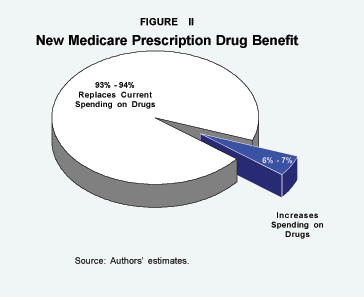That seniors lack access to prescription drugs is offered as a rationale for supporting a new Medicare prescription drug benefit. If many of them do in fact lack access, spending $400 billion in general tax revenues during the next 10 years for the benefit would increase seniors' use of drugs. The questions then are: What fraction of the Medicare population lacks prescription drug coverage, and how much more would they spend if they had coverage?
Based on 1998 data from the Medicare Current Beneficiary Survey (MCBS) conducted by the Centers for Medicare and Medicaid Services (CMS), 31 percent of the Medicare population does not have drug coverage. We estimate that overall drug spending among seniors would rise 5 to 7 percent with the addition of a prescription drug benefit to Medicare. If the new federal subsidy simply replaced spending now paid for by private insurers or Medicaid, the new benefit would shift the burden from one payer to another.
Who Pays for Seniors' Prescription Drugs?
Over the period 1994 to 2001, spending on prescription drugs jumped more than 157 percent from $54.6 billion to $140.6 billion. About one in every $6 is spent by the elderly. Of this spending:
- Out-of-pocket spending accounts for approximately 44 percent of seniors' total drug costs.
- The average share of spending paid out of pocket varies from 35 percent for those with private coverage to 20 percent for those with Medicaid.
- In 1998, 31 percent of Medicare beneficiaries had no prescription drug coverage, 10 percent had Medicaid and 59 percent had some private prescription drug coverage.
Medicaid covers prescription drugs for eligible low-income seniors. Seniors can purchase supplemental policies – called medigap insurance – that provide private prescription drug coverage, and some have benefits through an employer-sponsored retiree health plan. Employer sponsored plans make up the majority of private coverage. The Congressional Budget Office (CBO) estimates that nearly one-third of seniors with employer-sponsored benefits would lose coverage as companies dropped their plans.
Determinants of Spending on Prescription Drugs.
In our analysis, we used three sets of factors to explain spending on prescription drugs among the retired population: demographic characteristics, insurance coverage and health status. Our analysis showed that average prescription drug spending rises with age, then falls for seniors 80 years of age and older. We also found that Medicaid beneficiaries are in poorer health than seniors without prescription drug coverage. The MBCS data show that in health status, income and demographics, the uninsured are more like the privately insured than they are like Medicaid beneficiaries.
Furthermore, in 1998:
- About 89 percent of Medicare beneficiaries had some spending on prescription drugs, averaging $1,002 per beneficiary.
- Medicaid beneficiaries had the highest per capita spending, $1,216, followed by beneficiaries with private coverage, who averaged $1,066.
- Those without coverage spent an average of $813.

Determinants of Spending on Prescription Drugs.
The drug plans proposed by the U.S. House of Representatives and the Senate are less generous than many employer-based plans and Medicaid. However, individuals who currently lack coverage likely would spend more. Seniors who already have coverage would spend about the same as they do now. Employer-sponsored plans would probably act as supplements to the new drug benefit, so that the employees' overall coverage would remain at the pre-reform amount. A Medicare-based prescription drug plan would shift expenses from Medicaid to Medicare, but overall coverage for Medicaid patients probably would be unaffected. Thus if overall coverage rates and levels remained the same after reform, neither Medicaid beneficiaries nor most private plan participants would have an incentive to change their spending. Seniors not currently covered who bought into the new program would have an incentive to increase their spending, given that the direct cost to them would fall.
The amount by which spending would increase depends on the proportion of the uninsured that purchased the insurance and their subsequent demand. Assuming they changed their consumption behavior to resemble that of seniors who have private coverage:
- Total spending on prescription drugs would rise 5 percent to 7 percent, assuming 75 to 100 percent, respectively, of those who do not currently have prescription drug coverage purchased the new coverage.
- The CBO projects total spending on seniors' drugs of roughly $1.8 trillion over the 2004-2013 period; if a prescription drug benefit were in place over that period, drug spending would likely increase by $90 billion to $126 billion.
- Of the $400 billion taxpayers will spend on Medicare prescription drug benefits over the next 10 years, 6 to 7 percent will buy new drugs for seniors; the rest is a transfer from taxpayers that will replace existing spending by insurers and seniors. In October 2002, the CBO estimated that increased demand for drugs would account for 4 to 10 percent of costs under several drug benefit proposals.

Note that our figures may overstate increased drug spending, given that the typical private plan provides more generous coverage than the proposed plans. However, given our assumptions, the estimates provide an indication of the upper limit on the increase in overall spending.
Conclusion.
The 30 percent of Medicare beneficiaries who do not have prescription drug coverage would increase their spending if a drug benefit were added. Their spending would rise approximately 28 percent. However, spending by beneficiaries who currently have coverage would be unlikely to change unless their coverage were less generous than the proposed legislation. As a consequence, overall spending would increase only 5 percent to 7 percent with a prescription drug benefit. Most of Medicare's spending on prescription drugs would shift costs from Medicaid to Medicare and from seniors and third-party payers to taxpayers.
Andrew J. Rettenmaier is Executive Associate Director of the Private Enterprise Research Center at Texas A&M University and a senior fellow with the National Center for Policy Analysis. Zijun Wang is an associate research scientist at PERC.